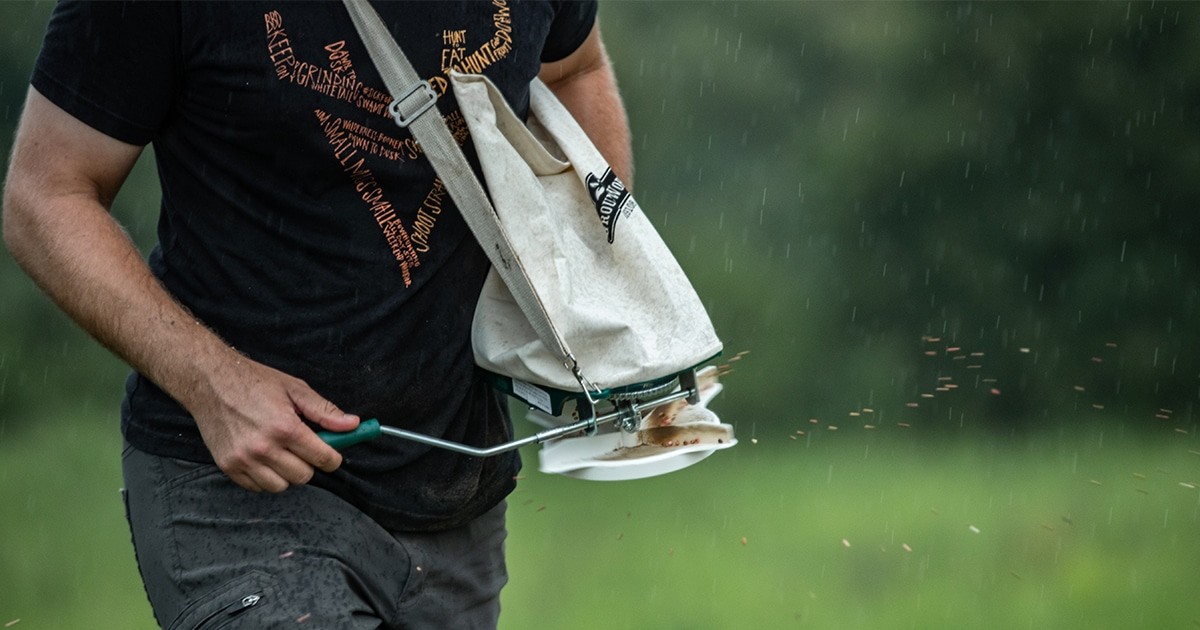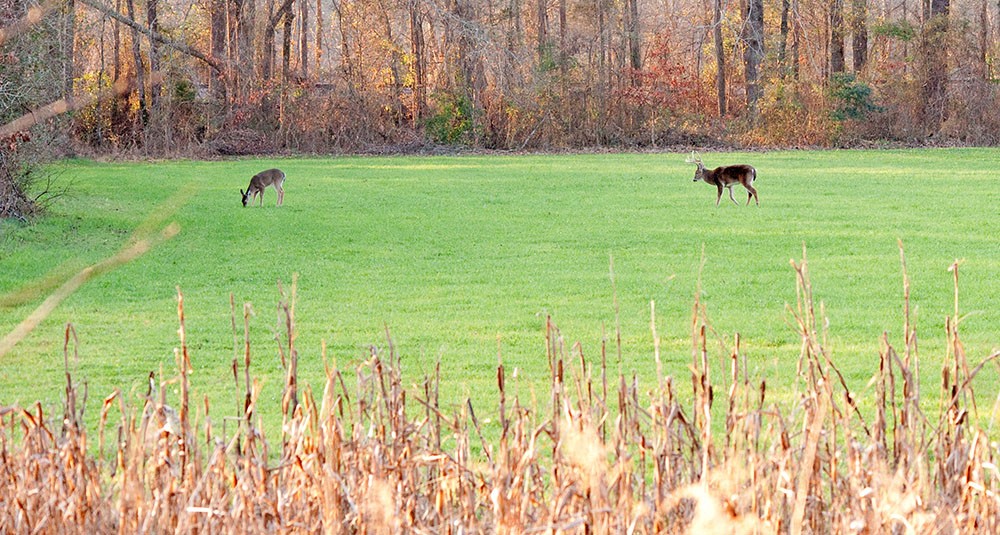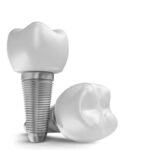Deer Food Plots, when thoughtfully planned and executed, become magnets for wildlife. This guide, brought to you by FOODS.EDU.VN, provides a straightforward, step-by-step approach to establishing and maintaining productive deer food plots. We will explore the essential elements of deer plot management, ensuring you create a thriving habitat that supports a healthy deer population. Whether you’re a seasoned hunter or a newcomer to land management, this guide equips you with the knowledge and practical steps to create successful game plots, attractive forage, and abundant food sources.
1. Selecting the Ideal Deer Food Plot Location
The foundation of a successful food plot lies in choosing the right location. Many potential plots fail before they even begin due to unsuitable environments. A critical evaluation of the land’s characteristics is the first step.
Key considerations include:
- Sunlight Exposure: Aim for at least six hours of direct sunlight daily. Insufficient sunlight inhibits the growth of most forage species. Consider the angle of the sun and how it changes throughout the growing season. South-facing slopes typically receive more sunlight.
- Moisture Levels: Adequate moisture is crucial, but waterlogged areas are detrimental. Observe how water drains after rainfall. Avoid areas with standing water or consistently soggy soil. Conversely, ensure the location isn’t excessively dry, especially in regions prone to drought.
- Soil Type: While soil can be amended, starting with a suitable base is advantageous. Loamy soils, a mixture of sand, silt, and clay, are generally ideal. However, adapt your plant selection to the existing soil conditions. Sandy soils drain quickly and may require more frequent watering, while clay soils retain moisture but can become compacted.
If your property is heavily wooded, creating openings or thinning the canopy to increase sunlight penetration is possible. Species tolerant of partial shade can also be selected, but yield will likely be lower compared to plots in full sun. According to the Quality Deer Management Association (QDMA), strategically placed food plots within a larger habitat mosaic can significantly improve deer carrying capacity.
2. The Indispensable Soil Test for Deer Food Plots
A soil test is not just a recommendation; it’s a necessity. Skipping this step is akin to cooking without a recipe—you might get lucky, but the odds are against you. A soil test provides a detailed analysis of your soil’s pH and nutrient content, guiding you on precisely what amendments are needed.
Here’s why a soil test is crucial:
- pH Balance: Soil pH affects the availability of nutrients to plants. Most forage species thrive in a slightly acidic to neutral pH range (6.0 to 7.0). If the pH is too low (acidic), liming is necessary to raise it. If the pH is too high (alkaline), sulfur can be used to lower it.
- Nutrient Levels: A soil test reveals deficiencies in essential nutrients like nitrogen (N), phosphorus (P), and potassium (K). These nutrients are vital for plant growth, root development, and overall health. The test results will recommend the appropriate amount of fertilizer to apply based on these deficiencies.
- Cost-Effectiveness: Applying lime or fertilizer without a soil test is guesswork. You might apply too much of one nutrient and not enough of another, wasting money and potentially harming your plants. A soil test ensures you’re only adding what the soil needs.
The process of taking a soil sample is simple. Collect samples from several locations within the plot area, mix them thoroughly, and send a representative sample to a certified soil testing laboratory. Follow the lab’s recommendations diligently. As noted by the National Deer Association (NDA), proper soil management is often the most overlooked aspect of successful deer food plots. You can contact FOODS.EDU.VN at 1946 Campus Dr, Hyde Park, NY 12538, United States or Whatsapp: +1 845-452-9600 for further assistance.
3. Simple Seed Mixes for Optimal Deer Attraction
It’s tempting to create a “super mix” with every imaginable forage species. However, simplicity often yields better results. Complex mixes can lead to competition between species, herbicide application challenges, and uneven growth.
Consider these advantages of simple seed mixes:
- Reduced Competition: Different species have varying growth rates, sunlight requirements, and nutrient needs. In a complex mix, aggressive species can outcompete weaker ones, reducing overall plot productivity.
- Targeted Weed Control: When you plant a single species or a simple mix of compatible species, you have more flexibility in controlling weeds. You can choose herbicides that target specific weed types without harming your desired forage.
- Consistent Growth: Simple mixes tend to result in more uniform growth, creating a consistent food source for deer.
When selecting a seed mix, consider the size of your plot and the local deer density. Species like cereal grains and clovers tolerate grazing pressure better than others. Soybeans, for instance, are highly palatable but can be decimated in small plots with high deer populations. Choose forage species adapted to your region’s climate and soil conditions. FOODS.EDU.VN offers detailed information on selecting region-specific forage mixes that thrive in diverse environments.
4. Planting Techniques for Thriving Deer Food Plots
Proper planting techniques are crucial for ensuring good seed-to-soil contact, which is essential for germination. The method you choose depends on your available equipment and the scale of your operation.
Here are three basic planting methods:
- Traditional Tillage: This involves using a tractor and disk or tiller to break up the soil, creating a prepared seedbed. Scatter the seed on the surface and then use a cultipacker or drag to ensure good seed-to-soil contact. This method is labor-intensive but effective for establishing a wide range of forage species.
- No-Till Drilling: This method involves using a no-till drill to plant seeds directly into the soil without prior tillage. It minimizes soil disturbance, reducing weed germination and erosion. Before drilling, spray the existing vegetation with a broad-spectrum herbicide like glyphosate to kill it.
- Broadcast Seeding: This simple method involves spraying the existing vegetation with a herbicide and then broadcasting the seed by hand or with a hand spreader. It’s best suited for small-seeded species like clovers and brassicas. Increase the seeding rate to compensate for seeds that won’t make it into the soil. Seeding right before a rain can help wash the seeds into the soil.
Selecting the right planting time is also critical. Cool-season forages like wheat, oats, and rye are typically planted in the fall, while warm-season forages like soybeans, corn, and sunflowers are planted in the spring. Consult local planting guides for optimal planting dates in your region.
5. Weed Management Strategies for Deer Food Plots
Weeds are an inevitable part of food plot management. However, not all weeds are detrimental. Many plants considered weeds are actually palatable to deer and can contribute to forage diversity.
Focus your weed control efforts on:
- Non-Native Species: These plants can be invasive and outcompete desirable forage species.
- Noxious Weeds: These weeds are harmful to livestock or wildlife and can spread rapidly.
- Weeds Competing with Forage: If weeds are significantly reducing the growth of your desired forage species, control measures are necessary.
Control methods include:
- Spot Spraying: Target individual weeds or small patches with a herbicide.
- Mowing: Mowing can help control broadleaf weeds in grass plots and vice versa.
- Crop Rotation: Rotating different forage species can help disrupt weed cycles.
- Pre-Emergent Herbicides: Apply herbicides before weed seeds germinate to prevent them from emerging.
Choosing the right herbicide is crucial. Consider the type of weeds you’re targeting and the forage species you’re trying to protect. Always read and follow the herbicide label instructions carefully. The University of Tennessee Extension provides detailed information on herbicide use in food plots.
6. Continuous Learning and Enjoyment in Deer Food Plot Management
Planting food plots is a continuous learning process. No amount of reading can fully prepare you for the challenges and rewards of land management. Embrace the process, experiment with different techniques, and learn from your successes and failures.
Key takeaways:
- Adapt to Local Conditions: What works in one region may not work in another. Adapt your practices to your specific climate, soil, and deer population.
- Monitor Your Plots: Regularly inspect your plots for weed infestations, nutrient deficiencies, and grazing pressure.
- Seek Expert Advice: Consult with local wildlife biologists, agricultural extension agents, or experienced food plotters.
- Enjoy the Process: Planting food plots is a rewarding way to connect with nature and contribute to wildlife conservation.
Even when you follow all the steps correctly, Mother Nature can sometimes throw a curveball. Droughts, floods, and severe weather events can impact your plots. Don’t get discouraged. Learn from these experiences and adapt your strategies for the future. Remember, every plot, successful or not, is a learning opportunity. FOODS.EDU.VN encourages you to share your experiences and learn from our community of food plot enthusiasts.
7. Enhancing Deer Food Plots with Supplemental Practices
Beyond the foundational steps, several supplemental practices can further enhance the attractiveness and productivity of your deer food plots.
- Fertilization: Regular fertilization based on soil test recommendations ensures that your forage species have the nutrients they need to thrive. Consider using slow-release fertilizers to provide a steady supply of nutrients over time.
- Liming: Maintaining the proper soil pH is crucial for nutrient availability. Lime applications may be necessary every few years to counteract soil acidity.
- Mowing: Mowing can stimulate new growth in certain forage species, making them more palatable to deer. It can also help control weeds and prevent them from going to seed.
- Irrigation: In arid regions or during periods of drought, supplemental irrigation can be essential for maintaining plot productivity.
- Fencing: Fencing can protect young seedlings from excessive grazing pressure, allowing them to establish properly. Electric fencing is often an effective and economical option.
Implementing these practices can significantly improve the quality and quantity of forage available to deer, increasing the carrying capacity of your land. The National Resources Conservation Service (NRCS) offers technical and financial assistance to landowners interested in implementing conservation practices on their property.
8. Integrating Food Plots into a Comprehensive Deer Management Plan
Food plots are just one component of a comprehensive deer management plan. To effectively manage your deer herd, it’s important to consider other factors such as:
- Habitat Management: In addition to food plots, manage the surrounding habitat to provide cover, water, and other essential resources.
- Harvest Management: Implement a harvest strategy that balances the deer population with the available resources.
- Predator Control: Manage predator populations to reduce fawn mortality.
- Supplemental Feeding: In areas with limited natural forage, supplemental feeding can help support the deer herd during critical periods.
A holistic approach to deer management is essential for creating a healthy and sustainable deer population. The Quality Deer Management Association (QDMA) provides resources and guidance on developing comprehensive deer management plans. FOODS.EDU.VN is committed to providing you with the resources and information you need to succeed in your deer management efforts.
9. Selecting Forage Species for Specific Needs in Deer Food Plots
The ideal forage species depend on your goals, the time of year, and your local climate. Here’s a breakdown of some popular options:
| Forage Species | Planting Season | Benefits | Considerations |
|---|---|---|---|
| Cereal Grains (Wheat, Oats, Rye) | Fall | Easy to establish, cold-tolerant, provides early-season forage | Can become stemmy and less palatable if not managed properly |
| Clovers | Spring/Fall | High in protein, attracts deer, improves soil health, long-lasting | Requires well-drained soil, can be slow to establish |
| Brassicas (Turnips, Rape, Kale) | Late Summer/Fall | Cold-tolerant, highly palatable, provides late-season forage | Can be susceptible to overgrazing, may require fertilization |
| Soybeans | Spring | High in protein, attracts deer, provides summer forage | Susceptible to overgrazing, requires good soil fertility |
| Corn | Spring | Provides high-energy food source, provides cover | Requires good soil fertility, can be expensive to establish |
| Sunflowers | Spring | Attracts deer, provides late-season food source, adds diversity to the plot | Can be susceptible to deer browsing, may require protection during early growth stages |


Experiment with different forage species to see what works best in your area. FOODS.EDU.VN provides detailed information on the nutritional value, planting requirements, and management practices for a wide range of forage species.
10. Advanced Deer Food Plot Strategies
For those looking to take their food plot game to the next level, consider these advanced strategies:
- Soil Amendments: Beyond basic liming and fertilization, consider using soil amendments like compost, manure, or biochar to improve soil health and fertility.
- Cover Crops: Planting cover crops during the off-season can help prevent erosion, suppress weeds, and improve soil health.
- Intercropping: Planting multiple forage species together in rows or strips can increase diversity and attract a wider range of wildlife.
- Rotational Grazing: Dividing your food plot into sections and rotating grazing can prevent overgrazing and allow forage species to recover.
- Prescribed Burning: In some areas, prescribed burning can be used to improve habitat quality and stimulate new growth in forage species.
These advanced strategies require more planning and effort, but they can significantly enhance the attractiveness and productivity of your deer food plots. Consult with local experts and research best practices before implementing these techniques. Remember, the goal is to create a thriving ecosystem that supports a healthy deer population and provides you with rewarding hunting opportunities. For more information, contact FOODS.EDU.VN at our website or Whatsapp: +1 845-452-9600.
By following these guidelines, you can create successful deer food plots that attract and nourish deer, enhance your hunting opportunities, and contribute to wildlife conservation. FOODS.EDU.VN is your partner in this journey, providing you with the knowledge, resources, and support you need to succeed.
FAQ about Deer Food Plots
Here are some frequently asked questions about deer food plots:
- What is a deer food plot? A deer food plot is a cultivated area planted with forage species to attract and provide supplemental food for deer and other wildlife.
- Why are deer food plots important? Food plots can improve deer nutrition, increase carrying capacity, attract deer for hunting, and enhance overall habitat quality.
- How do I choose the right location for a food plot? Consider sunlight exposure, moisture levels, soil type, and accessibility when selecting a location.
- What is the most important step in planting a food plot? Taking a soil test is arguably the most important step, as it determines the necessary soil amendments.
- What are some good forage species for deer food plots? Popular options include cereal grains, clovers, brassicas, soybeans, and corn.
- How do I control weeds in my food plot? Methods include spot spraying, mowing, crop rotation, and pre-emergent herbicides.
- How often should I fertilize my food plot? Fertilize based on soil test recommendations, typically once or twice per year.
- Can I plant a food plot in a wooded area? Yes, but you’ll need to select shade-tolerant forage species and consider thinning the canopy to increase sunlight penetration.
- How big should a food plot be? The ideal size depends on your goals and the size of your property, but even small plots can be beneficial.
- Where can I find more information about deer food plots? FOODS.EDU.VN provides a wealth of information on deer food plots and other wildlife management topics. Our address is 1946 Campus Dr, Hyde Park, NY 12538, United States.
This comprehensive guide equips you with the knowledge and practical steps to create successful deer food plots. Explore foods.edu.vn for even more in-depth articles and resources. Unlock the full potential of your land and create a thriving habitat for deer and other wildlife. Contact us for further information and personalized assistance!

